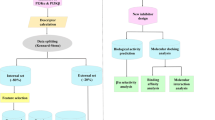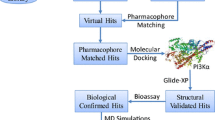Abstract
A desirable characteristic of PI3K inhibitors is their selectivity. Up to now, there has been no report that describes the 3 D-structure differences between two PI3Ks (δ and γ) and applies them to designing selective compounds. In the present study, we used an approach combining protein-structure modeling, GRID/PCA (Principal Component Analysis) and docking methods to investigate the detail interactions of the two PI3Ks with various chemical groups. At first, we constructed a 3 D-model of the PI3Kδ catalytic subunit with the program Modeller7.0 based on the high resolution X-ray structure of the PI3Kγ catalytic subunit, and then employed GRID and PCA to reveal the most relevant structural and physicochemical differences between the two PI3Ks related to their selectivity. As a result, the analysis unveiled the most important regions on the two PI3Ks that should be taken into account for the design of selective inhibitors. Finally, based on activity data of 10 PI3Kδ-selective compounds, a docking study validated the results of the GRID/PCA method, which suggested that the approach could provide clear guidelines for selective drug design.






Similar content being viewed by others
References
Vanhaesebroeck B, Waterfield MD (1999) Exp Cell Res 253:239–254
Stein RC, Waterfield MD (2000) Mol Med Today 6:347–357
Stephens LR, Eguinoa A, Erdjument-Bromage H (1997) Cell 89:105–114
Krugmann S, Hawkins PT, Pryer N, Braselmann S (1997) J Biol Chem 27:17152–17158
Hirsch E, Katanaev V, Garlanda C, Azzolino O, Pirola L, Sozzani S (2000) Science 287:1049–1053
Li Z (2000) Science 287:1046–1049
Sasaki T, Irie-Sasaki J, Jones RG, Olivera-dos-Santos AJ, Stanford WL, Bolon B, Wakeham A (2000) Science 287:1040–1046
Hirsch E, Ornella B, Philippe T, Muriel, L, Ronan C, Florella A, Matthias W (2001) FASEB J 15:2019–2021
Clayton E, Bardi G, Bell SE, Chantry D (2002) M J Exp Med 196:753–763
Jou ST, Carpino N, Takahashi Y, Roland P, Jyh-Rong C (2002) Mol Cell Biol 22:8580–8591
Okkenhaug K, Bilancio A, Farjot G, Priddle H, Sancho S, Peskett E, Pearce W (2002) Science 297:1031–1034
Phillips WA, Clair FS, Munday AD, Tomas RJ, Mitchell CA (1998) Cancer 83:41–47
Gershtein ES, Shatskaya VA, Ermilova VD, Kushlinsky NE (1999) Clin Chim Acta 287:59–67
Sadhu C, Masinovsky B, Dick K, Sowell CG, Sraunton DE (2003) J Immunol 170:2647–2654
Foukasn LC, Daniele N, Ktori C (2002) J Biol Chem 277:37124–37130
Sadhu C, Dick K, Treiberg J (2001) International patent 0181346 A2
Edward H Walker, Pacold ME, Perisic O, Stephens L, Hawkins PT (2000) Mol Cell 6:909–919
Djordjevic S, Driscoll PC (2002) TRENDS Biochem Sci 27:426–432
Goodford PJ (1985) J MC 28:849–857
Joliffe J (1986) Principal Component Analysis. Springer, Berlin
Wold S, Esbensen K, Geladi P (1987) Chemom Intell Lab Syst 2:37–52
Bairoch A, Apweiler R (2000) Nucleic Acid Res 28:45–48
Altschul SF, Madden TL, Schaffer AA, Jinghui Z, Zheng Z, Miller W (1997) Nucleic Acid Res 25:3389–3402
Berman HM, Westbrook J, Feng Z, Gilliland G, Weissig H (2000) Nucleic Acid Res 28:235–242
Thompson JD, Higgins DG, Gibson TJ (1994) Nucleic Acid Res 22:4673–4680
Sali A, Blundell TL (1993) J Mol Biol 234:779–815
Lindahl E, Hess B, van der Spoel D (2001) J Mol Mod 7:306–317
Laskowski RA, MacArthur MW, Moss DS (1993) J Appl Cryst 26:283–291
Colovos C, Yeates TO (1993) Protein Sci 2:1511–1519
Morris GM, Goodsell DS, Halliday RS (1998) J Comput Chem 19:1639–1662
Guex N, Peitsch MC (1997) Electrophoresis 18:2714–2723
Cerius 2 4.8 (1999) Accelrys Inc
Dauber-Osguthrope P, Roberts VA, Osguthorpe DJ, Wolff J, Genest M (1988) Proteins 4:31–38
Gasteiger J, Marsili M (1980) Tetrahedron 36:3219–3228
Weiner SJ, Kollman PA, Case DA, Singh UC, Ghio C, Alagona G, Weiner P (1984) J Am Chem Soc 106:765–773
Acknowledgements
We gratefully acknowledge financial support from the National Natural Science Foundation of China (No.30171088), Shanghai Key Disciplinary Foundation and “863” Project of China (No.2001 AA215261).
Author information
Authors and Affiliations
Corresponding author
Rights and permissions
About this article
Cite this article
Kuang, RR., Qian, F., Li, Z. et al. Study on improving the selectivity of compounds that inhibit two PI3Ks (gamma and delta). J Mol Model 12, 445–452 (2006). https://doi.org/10.1007/s00894-005-0069-8
Received:
Accepted:
Published:
Issue Date:
DOI: https://doi.org/10.1007/s00894-005-0069-8




